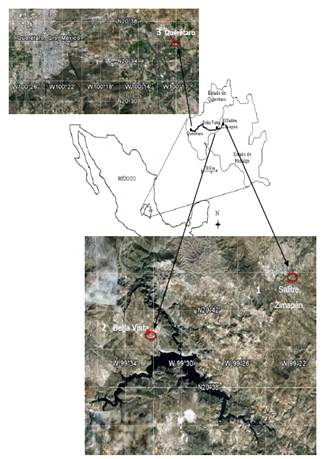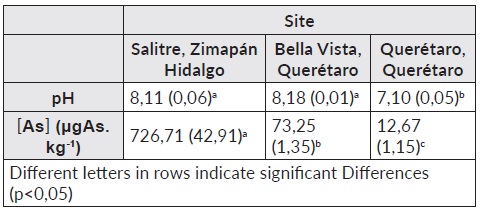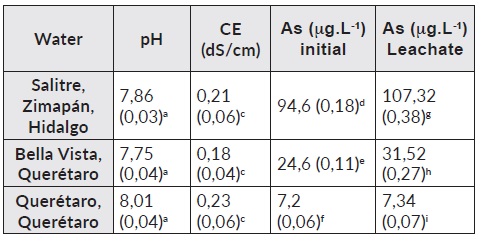INTRODUCTION
Arsenic is a toxic metalloid that is present in air, water and soil. In nature, it can be found as an inorganic form when combined with oxygen, sulfur and chlorides. Soil bacteria play an important role in the oxidation of this element. It is most prevalent form found in air samples is arsenic trioxide (As2O3) whereas a variety of arsenates (AsO4 3-) or arsenite (AsO2 -) are found in water, soil, or food [1,2]. Arsenic can act as genotoxic agent, causing adverse effects on human health and other organisms [3]. It is through inhalation of powders, ingestion of plants that have absorbed arsenic from soil, or from drinking Arsenic dissolved in that water that this element enters the food chain causing problems such as skin cancer (keratosis) as well as lung or liver cancer [4,5]. A number of studies have been conducted to detect genotoxic activity as a result of human activity, especially when mining in involved [6]. There are arsenic compounds that are known to induce mutagenic, carcinogenic and teratogenic effects resulting in a high incidence of oncological diseases [7]. Through experimental models genotoxic effects have been found in organisms exposed to these compounds. Clinical signs of these effects include gastrointestinal irritation, vomiting, diarrhea, nausea, and abdominal pain. These symptoms were observed in all cases, which were exposed to high doses of inorganic arsenic for a short-term and in low doses over a long-term [8,9]. In animal studies, lesions were found that caused gastrointestinal bleeding. For example, in monkeys that were given 6 mg As kg-1.day-1 diet for a month, intestinal inflammation and bleeding were found [6]. Currently, there are a large number of bioassays both in vitro and as well as short and long term, to determine the genotoxicity of inorganic arsenic. Tradescantia clone 4430 (Hybrid X T. T. Subacaulis hirsutiflora) is one of the bioassays that has been used to detect genotoxic effects of heavy metals [10,11]. Many studies mention that these plants are highly sensitive to toxins found in the environment such as pesticides and other inorganic compounds [11-17]. Chemicals such as lead tetra-acetate and arsenic trioxide induced micronucleus formation in Tradescantia clone 4430 (Trad-MCN) [13,18]. The aim of this study was to compare the effects of genotoxicity of six leachate soils from three separate sites semi-desert states located in the states of Querétaro and Hidalgo, Mexico, with known arsenic, using a bioassay (Trad-MCN).
METHOD
Samples
Soil and water samples from three sites located in the semi-desert area of the states of Querétaro and Hidalgo were taken. Site (1) El Salitre, is located within the mining district of Zimapán, with an altitude of 1,780 meters above sea level and 20°44' N 99° 23'W; Site (2), Bella Vista del Rio which is located at 20°40' N and 99°32'W to 20 miles from Salitre, along the border of the states of Hidalgo and Queretaro. The third site (3), which was used as control, near the town of Querétaro 20°35' N and 100°11' W (Figure 1).
Pots (30 in total) were prepared with 1,5 kg of soil. The soils were washed with 500 mL of water each site; Salitre in Zimapán, Bella Vista del Rio in Queretaro, and Queretaro soils (negative control). In addition, soil from Salitre was washed with ground water from Queretaro to which a concentration of arsenic (100 mg.L-1) was added to serve as a positive control. Over a time period of approximately four months four separate samples were obtained each with an interval of 21 days between preparations. The leachates were collected in plastic bags and kept refrigerated at -4ºC until used for genotoxicity tests.
Analysis of water
Water analysis was conducted in Salitre, Zimapán, Bella Vista and Queretaro. This same water was used for watering twice a month. The pH, conductivity (EC), redox potential (Eh), and the concentration of arsenic (As) were determined. These analyzes were used as a baseline for watering the pots, following the provisions of current Official Mexican Regulations [19].
Experimental conditions for obtaining leachate
In order to collect leachate from the pots previously mentioned the following experiment was performed; Experiment A: SZ-soil Zimapán (Salitre), washed with water from WZ-Zimapán. Experiment B: (SZ)-soil Zimapán (Salitre), washed with WQ-water from Querétaro. Experiment C: (SBV)- Bella Vista, Querétaro soil, washed with WBV-Agua Bella Vista, Querétaro; Experiment D: SBV- Bella Vista, Querétaro soil, washed with WQ- water from Querétaro.

Figure 1 Figure 1. Location of the sampling sites. 1) Salitre, Zimapán 20°44'51"N 99°22'15"W; 2) Bella Vista 20°40'35 "N 99°32'16" W; and 3) Querétaro 20 ° 35'52 "N 100°10'33" W.
Experiment F: SQ- Queretaro soil, uncontaminated, washed with WQ-Queretaro water as a negative control. A completely randomized design was carried out, taking random samples (five replications in each case).
Selecting cuts Tradescantia
Tradescantia clone 4430 (that is a hybrid of T. hirsutiflora, X T. subacaulis) is heterozygous was obtained from the greenhouse of the Centro de Estudios Academicos sobre Contaminacion Ambiental (CEACA) of the Autonomous University of Queretaro. Cultivation was carried out in the greenhouse under controlled conditions with light (1,800 watts Fluorescent, incandescent 180 watts) photoperiod (16/8 h light/dark), temperature 21ºC and 15ºC and approximately 16ºC at night. The relative humidity was maintained between 60 and 80% [20].
Trad-MCN
The following protocols were used [21-23], where inflorescences were selected with an approximate stem height of 10 cm, these were immersed in the aqueous extracts for each of the six experiments. Approximately 10 sections for each experiment were used and the treatments were conducted in a greenhouse under controlled conditions. The exposure time was 6 hours with 24 hours of recovery in Hoagland nutrient solution for each sample. The inflorescences were fixed in an ethanol - acetic acid (3:1) and stained with 0,5% acetocarmine. The number of cells in tetrad stage containing 1, 2, 3 or more micronuclei and 300 cells were counted for each preparation were recorded.
RESULTS
Characterization of the three soils and the water
The pH values, redox potential (Eh), electrical conductivity (EC) of the three soils showed some differences. The pH values classified as neutral for Querétaro soils [24,25] soils of Bella Vista and El Salitre moderately alkaline, the table 1 shows these results.
Table 1 Results of the averages of analysis of the soils of the three regions studied. In parenthesis is the standard deviation.

The CE of the three soils demonstrated similar and redox potential (Eh), they were classified as intermediate reducers without significant differences however with the Querétaro soil. There were significant differences [24]. Compared to Zimapán, Salitre soils where the concentrations were (726,71 ± 42,91 μg As.kg-1). These concentrations were the highest found. This is due to geomorphological origin. Next, in order of decreasing natural contamination, Bella Vista soil, with 73,25 ± 1,35 μg As.kg-1, which is ten times less than the soil of Salitre. In these two cases, the concentrations indicate the geographical proximity and identify them as soils with low As concentrations (<40 μg As.kg-1). The Querétaro soil which was taken only as reference contained concentrations of 12,67 ± 1,15 μg As.kg-1. The results of the characterization of the water used for irrigation are shown in cuadro 2.
Table 2 Average results of characterization of the water used for irrigation.

Different letters in the columns indicate significant differences (p <0,05)
A significant difference was determined in concentrations of As (in all cases HAsO4 -2 shaped, according to Pourbaix diagram Eh vs pH). It is observed that the initial concentration of As the water used to irrigate Zimapán exceeds 9,5 times the NOM-127-SSA1, so it is also valid for positive control; Water Bella Vista exceeds 2,5 times the standard and meets Querétaro water content <10 μg.L-1.
Genotoxic activity of leachate (Tradescantia clone 4430)
There are precedents that mention that soils may contain genotoxic compounds such as the study by [17] found an increase in the frequency of micronuclei in Tradescantia clone 4430 to expose this plant outage leached from soils contaminated with heavy metals. The results for genotoxicity of leachate from soils under study, can be seen in cuadro 3. The leachate SQ/WQ was taken as negative control, because in the water of this site concentration (As) is below the allowable limit set by the NOM-127-SSA1-1994 and presented a value of 1,6 ± 0,34 micronuclei. The leaching of SQ/WQC with 8,5 ± 0,37 micronuclei taken as a positive control, showed a significant difference from the control. This difference shown in the frequency of micronuclei is attributed to the concentration of arsenate added intentionally, but unlike the results found in leachate SZ/WZ and SZ/WQ which were 7,1 ± 0,21 and 4,8 ± 0,33 micronuclei micronuclei, respectively and also showed significant difference (p <0,01), the first very similar to SQ/WQC, but for this experiment also provided soil arsenic concentration in this case in previous studies was the soil with the highest concentration (726,71 g. kg-1 As) and because of this it can be said that the leachate more damage caused was to SZ/WZ, corresponding with the analysis in a study by the Institute of Geophysics of the National Autonomous University of Mexico (IGEF), arsenic found in water, soil and mineral sediments, in the Zimapán population of Hidalgo.
Table 3 Results of the frequency of micronucle/100 tetrads, exposed soil leachate Querétaro, Queretaro, Salitre Hidalgo and Bella Vista Qro.

(+) negative control; (-) Positive Control; As in μgAs.kg-1; MCNs / 100 tetrads.
Likewise Prieto et al. [26] found that the frequency of MNs in experimental Zimapán water samples showed significant differences from control in apical meristem cells of Vicia faba. Finally, in leachates from soils of Bella Vista SBV/WBV, it was found that this presented genotoxic damage with a frequency of 5,9 ± 0,80 micronuclei and SBV/WQ with a value of 5,2 ± 0,57 micronuclei between these two leachate no significant difference P>0,05 was presented, but if compared to the control group SQ/WQ, P <0,01. The values of arsenic (73,25 μg.kg-1) for this site were ten times lower compared to that found in soil Salitre, Zimapán in Hidalgo. With the average values of the four stages the correlation between the concentration of [As] and induction of micronuclei (MNs/100 tetrads) was established. In Figure 2 the linear correspondence with an R2 = 0,94 is shown, the slope of the equation (0,05) represents the speed of MCNs induced/100 tetrads per μgAs.L-1. The value of the intercept represents the number of MCNs induced/100 tetrads spontaneously (see figure 3).
There are a number of studies focused on the genotoxic evaluation of soil samples, obtaining good results, focusing on the preparation of leachate and make presentations with different bioassays [27-29]. Therefore it is said that mutagenicity bioassay Proven measures to assess the genotoxicity of complex mixtures without the need to specify the chemical characterization of the sample, determining the genetic damage in living organisms [27-31].
CONCLUSIONS
The results demonstrate that the micronuclei frequency was higher for soil leachate from the community of the Salitre, Hidalgo, and the community of Bella Vista del Río, Queretaro. Compared with the control group of leachates soil for the Municipality of Querétaro. In all cases there was a significant difference (Tukey p> 0,05). Also resulting in good linear correspondence R2 = 0,94 and the slope of the equation that represents a velocity induced MNs 100/0.05 tetrads each μgAs.L-1.
















